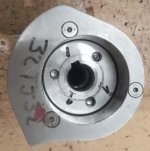How was the finish done on this stainless steel "screw"? It a mirror finish. Im not sure what type of stainless or if is indeed stainless at all. Its pretty heavy, definitely not aluminum, although it does have two aluminum clamps inside of it attached with three bolts. I have seen knife makers like John Grimsmo polish a knife to a mirror finish. Any input?












